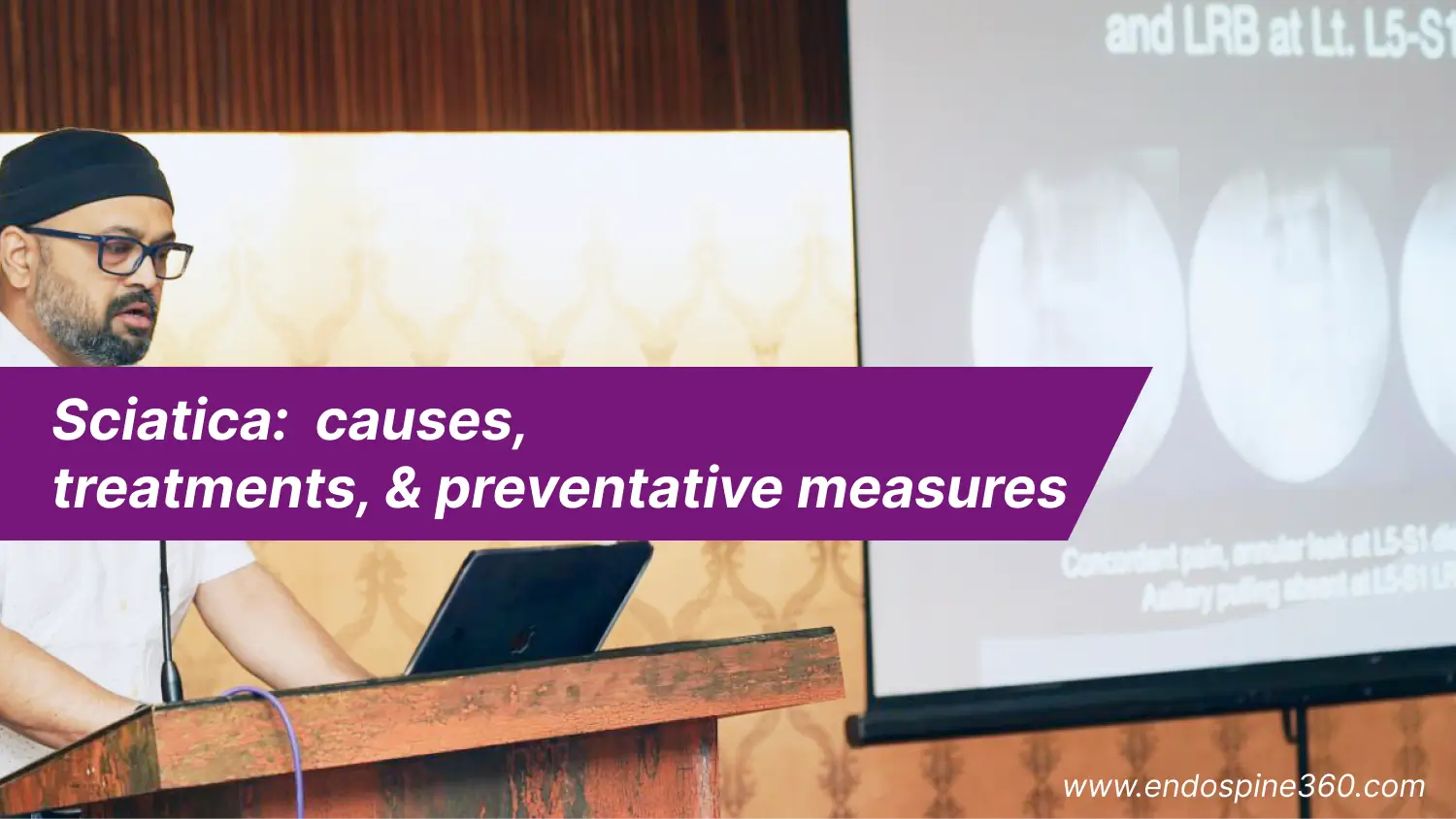Dr. Prasad discusses Sciatica, its causes, treatments, and preventative measures
- Endospine360
In a recent interview, we had the privilege of sitting down with Dr. Prasad Patgaonkar, an esteemed spine specialist and a leading authority on the diagnosis and treatment of sciatica.
Sciatica is a condition that affects millions of people worldwide, causing pain, discomfort, and limited mobility. Dr. Prasad shared valuable insights into the causes, treatment options, and preventive measures for sciatica. In this article, we will delve into our conversation with Dr. Prasad and shed light on this common yet often misunderstood condition.
Understanding Sciatica:
Sciatica refers to nerve pain that originates in the lower back and is felt through the buttock, down the back of the thigh, and into the calf. It typically affects one side of the body. It occurs when the sciatic nerve, the longest nerve in the body, becomes compressed. Dr. Prasad explained that various factors can contribute to the development of sciatica, including herniated discs, spinal stenosis, degenerative disc disease, and even certain lifestyle choices.
Causes of Sciatica:

During our interview, Dr. Prasad emphasized the importance of identifying the underlying causes of sciatica to determine the most appropriate treatment approach. He highlighted common culprits such as:
- Herniated Disc
- Spinal Stenosis
- Degenerative Disc Disease
- Spondylolisthesis
- Piriformis Syndrome
- Injury or Trauma
It is important to note that these are just a few of the common causes of sciatica. Each individual's case may be different, and a thorough evaluation by a spine expert is required to determine the underlying cause and to prepare an appropriate treatment plan.
Treatment Options:
Dr. Prasad discussed the wide range of treatment options available for sciatica, stressing the significance of individualized care. He explained that non-surgical treatments are often the first line of defense and may include physical therapy, pain management techniques, and targeted exercises to improve strength and flexibility. In cases where these non-surgical methods do not provide sufficient relief, Dr. Prasad highlighted the potential benefits of minimally invasive procedures, such as endoscopic discectomy, to alleviate pressure on the affected nerve. Here are some of the commonly recommended treatment options for sciatica:
Medications: Nonsteroidal anti-inflammatory drugs (NSAIDs) can help reduce inflammation and reduce pain. In more severe cases, oral corticosteroids or muscle relaxants may be prescribed to provide short-term relief.
Physical Therapy: Physical therapy plays an important role in managing sciatica. A skilled physiotherapist can design an exercise program for you that includes stretching, strengthening, and low-impact aerobic exercises. These exercises are included in your program keeping in mind your conditions and helping improve flexibility, strengthen the core muscles, and reduce the pressure on the sciatic nerve.
Heat and Cold Therapy: Applying heat or cold packs to the affected area can provide momentary relief from discomfort and inflammation. It helps relax your muscles and increases blood flow, while cold therapy benefits in reducing swelling and numbness.
Epidural Steroid Injections: When conservative treatments don't provide sufficient relief, epidural steroid injections may be considered by your spine consultant.
Surgical Intervention: Surgery is considered when conservative treatments fail to provide significant relief or if nerve compression requires immediate attention. Surgical options for sciatica include
Discectomy (removal of the herniated disc)
Laminectomy (removal of bone or tissue to relieve pressure)
Spinal fusion (joining two vertebrae together).
Preventative Measures:
When it comes to sciatica, prevention is always better than cure.
According to Dr. Prasad, while it may not be possible to completely prevent age-related degeneration of the spine, adopting good health habits can immensely reduce the risk of sciatica. Here are some key recommendations from Dr. Prasad to promote a healthy spine and prevent sciatica:
- Regular exercise
- Maintaining correct posture
- Maintaining the right weight
- Manage stress
- Regular checkups
The back is designed to support the entire body, and by adopting healthy habits and following preventive measures, everyone can maintain a strong and resilient spine.
Conclusion:
Our interview with Dr. Prasad Patgaonkar shed light on the causes, treatment options, and preventative measures for sciatica. With his expertise and dedication to patient care, Dr. Prasad provided valuable insights into managing this condition effectively. If you or a loved one is experiencing sciatica symptoms, it is important to consult a qualified spine specialist for a thorough evaluation and personalized treatment plan. Remember, early intervention and proper management can greatly improve the quality of life for individuals living with sciatica.
Checkout related pages: Spine Doctor Indore, Spine Doctor Mumbai , Sciatica Diagnosis and Treatment
Search
Categories
Popular Tags
Recent Post
-
Full endoscopic fellowship 2026

Fellowship in full endoscopic spine surgery under Dr. Prasad Patgaonka...
Read more -
From sciatica to disc problems: spinal diseases treated with endoscopic surgery in surat

Spine pain can quietly affect every part of your life—from walking and...
Read more -
Top spine hospitals in surat offering endoscopic & minimally invasive surgery

Back and spine problems can affect your daily activities, mobility, an...
Read more -
Spine health matters: trusted surgeons and specialists in surat

Your spine plays a vital role in supporting your body, enabling moveme...
Read more



